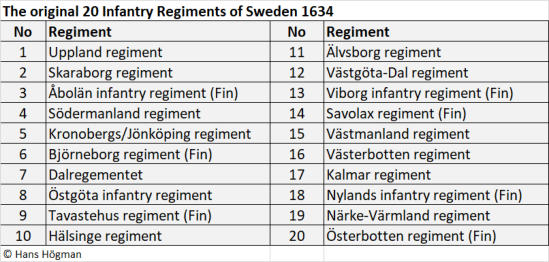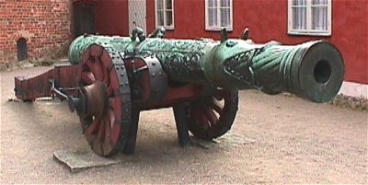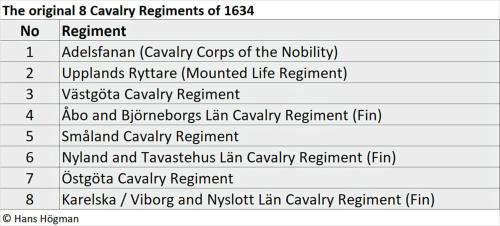

Copyright © Hans Högman 2017-07-25


The Early Allotment System,
"Äldre indelningsverket"
The Early Allotment System was a system of
organizing and financing the Swedish armed forces
in earlier times.
1500s
The Early Allotment
System was
established during the
Rule of King Gustav
Vasa, i.e. mid-1500s.
After the Liberation
War (1521 - 1523) King Gustav began building an
army manned by foot-soldiers through
conscription (utskrivning) and cavalrymen through a
system called rusttjänst.
At the parliamentary session in Arboga in 1536 it
was decreed that cavalry units was to be
established in the different provinces of Sweden. In
the parliamentary session in Västerås in 1544 a
corresponding decreed was taken about infantry
units in the Swedish provinces. The cavary units
was called “fanor” and the infantry units was called
“fänikor”.
The foot-soldiers was enrolled through
involuntary conscription (utskrivning). The
cavalrymen was enrolled through a voluntary
system called “rusttjänst”. The “rusttjänst “was
upheld by farmers (freeholders) who provided a
cavalryman with a horse to the cavalry unit in the
province. The holder of the rustjänst (the
freeholder) was in return exempted from taxes.
However, it was common that the freeholder
himself was the cavalryman, i.e. the freeholder
enrolled himself as the cavalryman of the “rusthåll”.
The navy sailors (båtsmän) provided in a similar
manner as the foot-soldiers.
1600s
During the Rule of King Gustav II Adolf (1611 -
1632) the Swedish armed forces was modernized
both tactically and organizationally. The different
military units was reorganized into modern
regiments in 1623 and at least one infantry
regiment was stationed in each province. Cavalry
regiments was also stationed in most provinces.
These regiments were therefore known as
provincial regiments (landskapsregementen). This
reorganization of the armed forces was later
adopted in the Swedish Constitution Act of 1634.
According to the 1634 Constitution Act, 20 infantry
regiments (13 in real Sweden and 7 in Finland) and
8 cavalry regiments (5 in real Sweden and 3 in
Finland) was to be established. Note: Finland was a
part of Sweden until 1809.
An infantry regiment normally numbered 1,200
soldiers (privates and corporals) plus the
commissioned and non-commissioned officers.
The 1,200 soldiers of a infantry regiment were
organized into 8 Companies of 150 men each. Four
Companies made a Battalion (600 soldiers) and
there were two battalions in a regiment.
The Colonel was the regimental commander and
the commander of the 1st battalion. The Lieutenant
Colonel was the regimental commander’s deputy
and the commander of the 2nd battalion.
A Captain commanded each Company. The 1st
Company of a regiment was called the Life
Company.
The original 20 Infantry Regiments of 1634
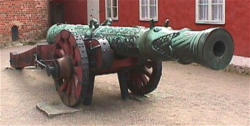
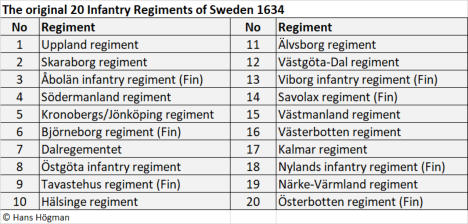
The Allotment System -
Sweden (2)
The original 8 Cavalry Regiments of 1634
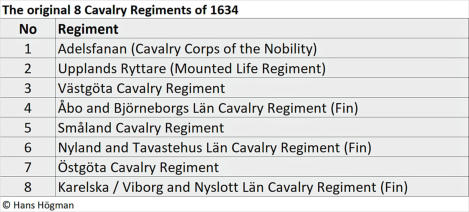
(Fin) in the charts above means that these
regiments were established in Finland (Finland was
a part of Sweden until 1809).
Infantry
In the Early Allotment System the soldiers in the
infantry and the navy personnel were enrolled and
maintained in a system call "utskrivning"
(involuntary conscription).
In the rural parishes every fit man were grouped
together in a "rote" (ward). Each "rote" consisted of
10 chosen men between the age of 15 and 40. One
man per each "rote" was involuntary recruited to
serve in the regiment of the province.
Note: a “rote” in the Early Allotment System used by
the conscription system was not the same thing as a
“rote” in the Late Allotment System.
The towns and cities were not a part of the army
recruiting system but the navy recruited in towns
and cities as well as in the countryside.
Cavalry
The cavalrymen was enrolled through a voluntary
system called “rusttjänst”. The “rusttjänst “was
upheld by farmers (freeholders) who provided a
cavalryman with a horse to the cavalry unit of the
province. The holder of the rustjänst (the
freeholder) was in return exempted from taxes.
However, it was common that the freeholder
himself was the cavalryman, i.e. the freeholder
enrolled himself as the cavalryman of his “rusthåll”.
Navy
The navy sailors (båtsmän) provided in a similar
manner as the foot-soldiers. The navy seaman were
above all recruited from coastal areas as well as
from towns and cities.
The System
The recruiting requirements for each conscription
occasion was decided by the government every time
when there was a need to mobilize the army.
Normally the veterans were recruited first.
This system had many disadvantages. The General
staff never knew in advance how many soldiers they
would be able to enroll each time. So, they never
really knew the strength of their forces in advance.
The system was also widely disliked by the
freeholders and their farmhands. At any time a
farmer or his farmhands could be designated the
"10th man of the rote" at times of war with no
alternatives but to be involuntarily enrolled by the
army.
However, hiring of substitutes was allowed. If the
soldier’s family was wealthy enough they could hire
someone else to take his place. The only persons
that would accept to take someone else’s place
when drafted were people among the poor. The
army then didn’t get the best-qualified soldiers.
The soldiers serving in the army in the Early
Allotment System, chosen by "utskrivning", were paid
a salary when they were at war. But in peace time
the Crown could not afford to keep a standing army
so the soldiers were disbanded and sent back home
to take care of themselves as best as the could.
Another problem with those involuntary chosen
soldiers was the large number of desertions.
So, there was no standing army at this time accept
for the Lifeguard Regiments and the Regiments
garrisoned at the fortresses around the nation. They
were paid a salary all year round.
The Early Allotment System was mainly a way to
organize the armed forces even if the cavalry
system was similar to the so-called Late Allotment
System.







